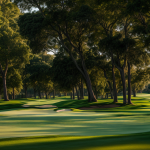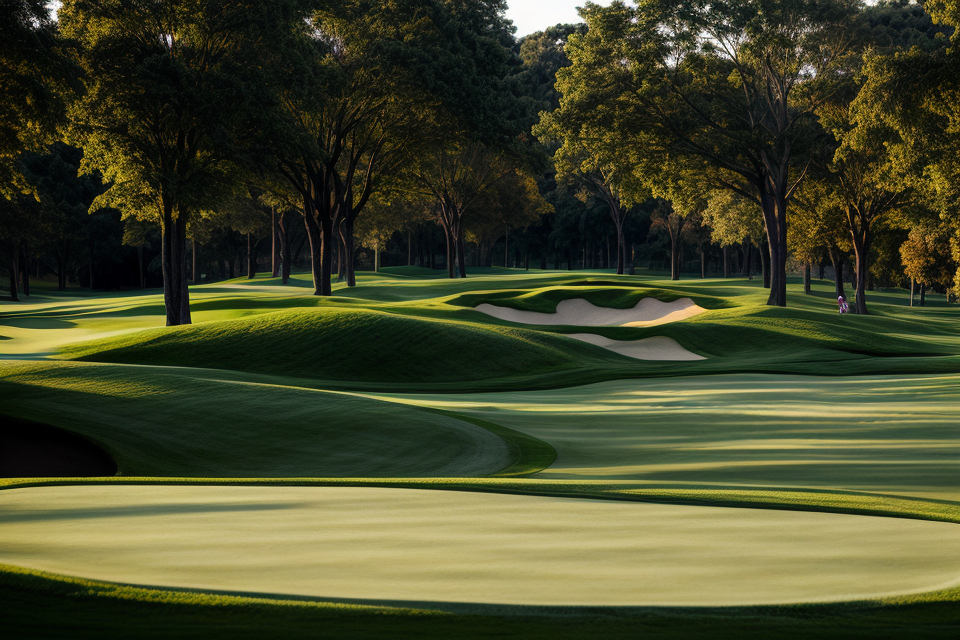Designing a golf course is a challenging task that requires a lot of creativity, knowledge, and expertise. A golf course is not just a piece of land with holes dug in it; it’s a work of art that requires careful planning and execution. In this comprehensive guide, we will explore the intricacies of designing a golf course, from the initial planning stages to the final construction. We will discuss the key factors that need to be considered, such as the landscape, climate, and player skill level, and provide tips on how to create a golf course that is both visually stunning and challenging for players of all levels. Whether you’re a seasoned golf course designer or just starting out, this guide will provide you with valuable insights and practical advice to help you create a golf course that will stand the test of time.
Planning and Site Analysis
Determining the Course’s Purpose and Goals
Playability and Skill Level
The purpose of a golf course should be determined based on the target audience. For instance, a course designed for beginners should be easier to play, with wider fairways and shorter holes. On the other hand, a course designed for advanced players should have tighter fairways, steeper slopes, and longer holes.
Aesthetics and Environmental Preservation
A golf course should not only be functional but also visually appealing. The course’s design should complement the surrounding landscape and enhance the natural beauty of the area. Environmental preservation should also be considered in the design process. This includes minimizing the impact on wildlife habitats, preserving water resources, and reducing waste.
By considering these factors during the planning and site analysis phase, the golf course designer can create a course that meets the needs of the target audience while also preserving the natural environment.
Conducting a Site Analysis
Topography and Soil Conditions
When conducting a site analysis for designing a golf course, it is essential to evaluate the topography and soil conditions of the land. The topography refers to the shape and features of the land, including hills, valleys, and natural drainage patterns. The soil conditions, on the other hand, refer to the type of soil present and its suitability for growing turfgrass, which is the primary surface used on golf courses.
A golf course designer should assess the topography of the site to determine the natural contours and elevation changes that can be used to create interesting and challenging holes. The designer should also evaluate the soil conditions to determine the suitability of the land for growing turfgrass. Soil testing should be conducted to determine the pH levels, nutrient content, and organic matter content of the soil. This information will help the designer to select the appropriate grass species and to develop a soil management plan to ensure optimal growth and maintenance of the turfgrass.
Water Features and Hazards
Water features, such as lakes, ponds, and streams, can add beauty and challenge to a golf course. A designer should evaluate the site to determine if there are any existing water features that can be incorporated into the design. If not, the designer may need to create new water features, such as ponds or wetlands, to enhance the course’s aesthetics and challenge.
In addition to water features, hazards such as bunkers, roughs, and out-of-bounds areas should be evaluated during the site analysis. The designer should consider the placement of these hazards to challenge golfers while still providing them with a fair test of their skills.
Vegetation and Wildlife Habitats
During the site analysis, the designer should also evaluate the existing vegetation and wildlife habitats on the site. The designer should consider how the existing vegetation can be incorporated into the design and how it can be used to enhance the course’s aesthetics. The designer should also evaluate the site for any endangered or protected species and develop a plan to minimize any impact on their habitats.
Overall, conducting a site analysis is a crucial step in the process of designing a golf course. It allows the designer to evaluate the natural features of the land and determine how they can be used to create an interesting and challenging course that will provide golfers with a memorable experience.
Creating a Master Plan
Creating a master plan is a crucial step in designing a golf course. It involves developing a comprehensive overview of the entire golf course, taking into account factors such as topography, drainage, vegetation, and existing infrastructure. The master plan serves as a blueprint for the entire golf course design process, guiding the designer in making informed decisions on the layout, design principles, green complex design, and hole design.
Course Layout and Design Principles
The course layout is the first step in creating a master plan. The designer must consider the available land, the desired number of holes, and the intended length and difficulty of the course. The design principles are based on the idea of creating a challenging yet fair course that is enjoyable for golfers of all skill levels. Some of the key design principles include:
- Variety: The course should offer a variety of hole types, including par 3s, par 4s, and par 5s, as well as left-hand and right-hand holes to challenge golfers.
- Risk/reward: The course should offer opportunities for golfers to take risks, such as by going for a green in two, but also provide a way to recover if they miss.
- Flow: The course should have a logical flow from hole to hole, with each hole flowing into the next and building on the previous hole’s challenge.
Green Complex Design
The green complex design is an important aspect of the master plan. The designer must consider the shape, size, and contour of the greens, as well as the placement of hazards, bunkers, and other features that can affect the golfer’s approach to the green. The goal is to create a challenging yet fair green complex that rewards good shots and punishes poor ones.
Hole Design and Shot Values
The master plan should also include the design of each hole, including the shot values of each hole. The designer must consider the length of the hole, the wind direction, and the placement of hazards and other features that can affect the golfer’s shot selection. The goal is to create a hole that offers a challenge to golfers of all skill levels, while still being enjoyable and fair.
Overall, creating a master plan is a crucial step in designing a golf course. It provides a comprehensive overview of the entire golf course, guiding the designer in making informed decisions on the layout, design principles, green complex design, and hole design.
Selecting and Installing Golf Course Turfgrass
Choosing the Right Turfgrass Varieties
When it comes to designing a golf course, choosing the right turfgrass varieties is crucial. The type of grass used on a golf course can have a significant impact on the playing conditions, aesthetics, and overall performance of the course. In this section, we will discuss the different turfgrass varieties commonly used on golf courses and their specific characteristics.
Golf Course Putting Greens
Putting greens are the most critical area of a golf course, as they are where the golfer’s final shot is taken. For this reason, the turfgrass used on putting greens must be of the highest quality and provide a consistent, true roll. The most common turfgrass varieties used on putting greens are creeping bentgrass, annual bluegrass, and poa annua. Creeping bentgrass is the most popular choice due to its fine texture, high density, and excellent putting surface. However, it can be more challenging to maintain than other varieties.
Fairways and Roughs
Fairways and roughs are the largest areas of a golf course and require a turfgrass variety that can withstand heavy traffic and tolerate various weather conditions. The most common turfgrass varieties used on fairways and roughs are Kentucky bluegrass, perennial ryegrass, and tall fescue. Kentucky bluegrass is known for its aesthetic appeal and fine texture, while perennial ryegrass is prized for its high wear tolerance and ability to thrive in cooler climates. Tall fescue is a durable and drought-tolerant grass that is often used in the roughs to provide a more natural appearance.
Greenside and Approach Areas
Greenside and approach areas are where the golfer’s approach shot is taken, and the turfgrass used in these areas must be able to withstand the heavy traffic and wear and tear from golf balls. The most common turfgrass varieties used in these areas are creeping bentgrass, annual bluegrass, and poa annua. Creeping bentgrass is often used due to its fine texture and excellent putting surface, while annual bluegrass is prized for its ability to recover quickly from damage. Poa annua is a low-maintenance grass that is often used in the approach areas due to its tolerance for close mowing and wear.
In conclusion, choosing the right turfgrass varieties is a crucial step in designing a golf course. The type of grass used can have a significant impact on the playing conditions, aesthetics, and overall performance of the course. When selecting turfgrass varieties, it is essential to consider factors such as climate, traffic, and maintenance requirements to ensure that the chosen grass can withstand the demands of the course and provide the best possible playing conditions for golfers.
Establishing a Maintenance Program
Soil Testing and Fertilization
Before implementing any maintenance program, it is crucial to understand the soil’s composition and nutrient content. Soil testing provides valuable information on the soil’s pH levels, nutrient content, and organic matter. Based on the test results, a fertilization program can be developed to address any nutrient deficiencies. It is important to use a balanced fertilizer that contains a mix of nitrogen, phosphorus, and potassium to promote healthy growth.
Pest Management and Integrated Pest Control
Golf courses are susceptible to various pests, including insects and diseases, which can cause damage to the turfgrass. An integrated pest management (IPM) approach should be adopted to minimize the use of chemical pesticides and prevent environmental harm. This approach involves monitoring the course for signs of pest infestations, identifying pest species, and implementing cultural and biological control methods before resorting to chemical pesticides.
Irrigation and Drainage Systems
A well-designed irrigation and drainage system is crucial for maintaining a healthy golf course. Proper irrigation ensures that the turfgrass receives adequate water, while effective drainage prevents waterlogging and reduces the risk of disease. It is important to use efficient irrigation systems, such as sprinklers and drip irrigation, to conserve water. Additionally, a proper drainage system, including surface and subsurface drainage, should be installed to prevent water from accumulating on the course.
Constructing and Equipping the Golf Course
Earth Moving and Grading
Excavation and Site Clearing
Excavation and site clearing are crucial initial steps in the earth moving and grading process of designing a golf course. This involves removing any unwanted vegetation, rocks, and debris from the construction site. It is important to ensure that the site is free from any obstacles that may hinder the smooth flow of construction activities. The excavated materials are typically transported to designated disposal areas to prevent any environmental hazards.
Terrain Shaping and Gradient Control
Terrain shaping and gradient control are critical components of earth moving and grading in golf course design. These activities involve modifying the natural contours of the land to create a suitable layout for the golf course. Gradient control involves the management of slopes and gradients to ensure that the golf course is accessible and playable for golfers of all skill levels.
The golf course designer must consider various factors such as drainage, soil stability, and aesthetics when shaping the terrain. The use of heavy machinery such as bulldozers, excavators, and graders is essential in reshaping the land to create the desired slopes, bunkers, and other features. The terrain should be shaped in a way that enhances the visual appeal of the golf course while also providing a challenging and enjoyable experience for golfers.
Additionally, the golf course designer must ensure that the terrain is graded to allow for efficient water flow and proper drainage. This is important in preventing waterlogging and ensuring that the golf course remains playable during rainy weather. Proper gradient control also helps to reduce erosion and maintain the stability of the land.
In summary, terrain shaping and gradient control are critical aspects of earth moving and grading in golf course design. These activities involve modifying the natural contours of the land to create a suitable layout for the golf course while ensuring proper drainage and stability. The use of heavy machinery and careful consideration of various factors are essential in achieving the desired outcome.
Installing Drainage and Irrigation Systems
Proper drainage and irrigation systems are essential components of a golf course. These systems help maintain the health and playability of the turf, as well as protect the course from damage during heavy rain and other extreme weather conditions.
Water Management and Conservation
Water management and conservation are critical aspects of designing and maintaining a golf course. Golf courses can be significant users of water, especially in areas with hot and dry climates. Therefore, it is crucial to design and install drainage and irrigation systems that efficiently use and conserve water.
One way to conserve water is to use recycled water for irrigation. Recycled water is treated wastewater that has been purified to meet the same standards as drinking water. By using recycled water, golf courses can reduce their water usage and lower their water bills.
Another way to conserve water is to use drought-tolerant grasses and plants. These plants require less water than traditional grasses and plants, which helps reduce water usage and save costs.
Drainage System Design and Installation
A well-designed drainage system is essential for maintaining a healthy golf course. The drainage system should be designed to quickly and efficiently remove excess water from the course, while also preventing ponding and standing water.
There are several types of drainage systems that can be used in golf courses, including surface drainage, subsurface drainage, and combination systems. Surface drainage involves the use of drainage pipes and gutters to collect and remove surface water from the course. Subsurface drainage involves the use of perforated pipes and gravel to collect and remove water from the soil. Combination systems use both surface and subsurface drainage methods to effectively remove water from the course.
The type of drainage system used will depend on the specific needs of the golf course, including the soil type, topography, and climate. A golf course designer or architect will work with a team of engineers and contractors to design and install the drainage system that best meets the needs of the course.
Once the drainage system is installed, it is essential to regularly maintain and monitor it to ensure that it is functioning properly. Regular maintenance includes cleaning out drainage pipes and gutters, as well as checking for any areas where the system may need to be repaired or upgraded. By properly maintaining the drainage system, golf courses can ensure that they remain healthy and playable, even during periods of heavy rain and other extreme weather conditions.
Building Golf Course Structures and Facilities
Clubhouses and Other Buildings
The clubhouse is the central hub of any golf course, serving as a gathering place for players and a hub for operations. Designing a clubhouse requires careful consideration of the course’s size, location, and overall aesthetic. Key elements to consider include:
- Size and layout: The clubhouse should be large enough to accommodate the needs of the course, but not so large as to overwhelm it. The layout should be functional and efficient, with ample space for players to relax and socialize.
- Style and aesthetics: The clubhouse should complement the overall aesthetic of the course, blending seamlessly with the natural surroundings. This may involve selecting materials and colors that match the local landscape, or incorporating design elements that reflect the course’s theme or history.
- Amenities and services: The clubhouse should offer a range of amenities and services to meet the needs of players, including locker rooms, pro shops, dining areas, and event spaces. It should also be equipped with modern technology and infrastructure, such as wireless internet and audiovisual equipment, to support events and other activities.
Cart Paths and Sidewalks
Cart paths and sidewalks are essential components of any golf course, providing players with a safe and convenient way to navigate the course. When designing these features, it is important to consider the following factors:
- Materials and construction: Cart paths and sidewalks should be constructed from durable materials that can withstand heavy use and weather conditions. Common materials include asphalt, concrete, and crushed stone.
- Width and layout: Cart paths and sidewalks should be wide enough to accommodate golf carts and pedestrians, with ample space for players to pass each other. The layout should be designed to minimize interference with the golf course, avoiding steep slopes and other obstacles that may pose a hazard.
- Integration with the course: Cart paths and sidewalks should be designed to blend seamlessly with the natural surroundings, using landscaping and other design elements to create a cohesive aesthetic. This may involve incorporating bridges, tunnels, or other features that allow players to cross streams or other obstacles without leaving the path.
Sand Traps and Bunkers
Sand traps and bunkers are strategically placed hazards that challenge players and add an element of risk to the game. When designing these features, it is important to consider the following factors:
- Location and placement: Sand traps and bunkers should be placed in strategic locations where they will challenge players and force them to make difficult shots. They should be visible from the tee box and fairway, allowing players to assess the risk and plan their approach.
- Size and shape: Sand traps and bunkers should be large enough to challenge players, but not so large as to be unfair or overwhelming. The shape should be varied, with slopes, curves, and other features that create different challenges and require different skills.
- Construction and maintenance: Sand traps and bunkers should be constructed from materials that are resistant to erosion and provide a stable base for the sand. They should be maintained regularly to ensure that the sand is consistent and the hazard is challenging but fair.
Operating and Maintaining the Golf Course
Managing Playability and Course Conditions
Managing playability and course conditions is a critical aspect of operating and maintaining a golf course. The following are some of the key considerations in this regard:
Bunker Maintenance and Renovation
Bunkers are an essential part of a golf course, and their maintenance and renovation can significantly impact the course’s playability. Bunker maintenance involves raking and cleaning the sand after each use, as well as repairing any washouts or erosion. Bunker renovation, on the other hand, involves restoring the bunker to its original design specifications, which may include re-shaping the bunker, re-sanding, or adding new sand.
Tree and Shrub Pruning
Trees and shrubs are essential to the aesthetics of a golf course, but they can also affect playability if not properly maintained. Regular pruning is necessary to maintain the shape and size of trees and shrubs, as well as to remove any dead or damaged branches. Pruning should be done in a way that minimizes the impact on the golf course’s playability, and should be done at the appropriate time of year to ensure the health of the plants.
Aerification and Renovation Techniques
Aerification is the process of relieving soil compaction and promoting healthy root growth by removing small plugs of soil and replacing them with air. Aerification is typically done in the off-season and is an essential part of maintaining a healthy golf course. Other renovation techniques may include overseeding, topdressing, and fertilization, all of which help to maintain the course’s playability and overall health.
Maintaining Equipment and Infrastructure
Golf Cart Fleet Management
Ensuring the golf carts are well-maintained is crucial for smooth operations and to prevent breakdowns that may cause delays and disruptions to the game. The fleet management should include regular maintenance checks, inspections, and repairs to keep the carts in good working condition. The following tasks should be included in the fleet management:
- Regularly checking the batteries, charging systems, and motor systems
- Inspecting the brakes, steering, and tires
- Replacing worn-out parts and accessories
- Keeping records of maintenance and repairs
Maintenance of Greens, Tees, and Fairways
The condition of the greens, tees, and fairways significantly impacts the playing experience of golfers. Therefore, regular maintenance is essential to ensure that the course remains in good condition throughout the year. The following tasks should be included in the maintenance of the greens, tees, and fairways:
- Mowing and trimming the grass to maintain the desired height and shape
- Aerating and overseeding to improve the soil’s health and structure
- Applying fertilizers and pesticides to maintain the health and appearance of the turf
- Monitoring and addressing any issues such as disease, pests, or weeds
Cart Path Maintenance and Repair
Cart paths are an essential part of the golf course infrastructure, and their condition can significantly impact the golfers’ experience. Cart path maintenance and repair should include the following tasks:
- Inspecting the cart paths for any damage, such as cracks, potholes, or erosion
- Repairing any damage using appropriate materials, such as concrete, asphalt, or gravel
- Maintaining the cart paths by sweeping or blowing debris and clearing any obstructions
- Replacing worn-out or damaged cart path markers and signs
By following these guidelines, golf course operators can ensure that their equipment and infrastructure are well-maintained, providing a smooth and enjoyable experience for golfers.
Implementing Safety Measures and Best Practices
Golf courses are complex operations that require careful planning and management to ensure the safety of all personnel and visitors. In this section, we will discuss some of the key safety measures and best practices that should be implemented when operating and maintaining a golf course.
Lightning Safety Protocols
Lightning is a serious hazard on golf courses, particularly during thunderstorms. To protect players and staff from lightning strikes, it is important to have a clear lightning safety protocol in place. This may include:
- Providing shelter for players and staff in the event of a thunderstorm
- Ensuring that all players and staff are aware of the location of the nearest shelter
- Encouraging players to leave the course if they feel threatened by lightning
- Providing emergency medical services in case of a lightning strike
Chemical Safety and Handling
Golf courses use a variety of chemicals to maintain the turf, control pests, and treat injuries. It is important to handle these chemicals safely to avoid accidental exposure or environmental contamination. This may include:
- Providing proper training to staff on the safe handling and storage of chemicals
- Using personal protective equipment (PPE) such as gloves and masks when handling chemicals
- Storing chemicals in designated areas away from food and beverage areas
- Disposing of chemicals properly in accordance with local regulations
Golf Cart Safety Guidelines
Golf carts are a common mode of transportation on golf courses, but they can also be dangerous if not used properly. To ensure the safety of players and staff, it is important to establish clear golf cart safety guidelines. This may include:
- Providing training to staff on the safe operation of golf carts
- Requiring all players to wear seat belts while in golf carts
- Limiting the speed of golf carts to designated areas
- Ensuring that all golf carts are regularly maintained and inspected for safety.
Continuous Improvement and Course Upgrades
Continuous improvement and course upgrades are crucial to maintaining a golf course’s quality and relevance. A well-designed golf course requires regular maintenance and upgrading to ensure that it remains challenging, visually appealing, and sustainable. In this section, we will discuss the various aspects of continuous improvement and course upgrades.
Monitoring and Responding to Climate Change
Climate change is a significant challenge facing golf course designers and managers. Rising temperatures, changes in precipitation patterns, and more frequent extreme weather events can affect the playing conditions, course infrastructure, and vegetation. Therefore, it is essential to monitor and respond to climate change by adopting sustainable practices, incorporating drought-resistant plants, and implementing water-efficient irrigation systems. Additionally, golf course designers and managers should consider incorporating natural features, such as wetlands and meadows, to help mitigate the effects of climate change.
Upgrading and Expanding Facilities
Upgrading and expanding facilities are crucial to maintaining a golf course’s competitiveness and attractiveness. As golf technology and equipment improve, golf courses must also adapt to ensure that they remain challenging and relevant. Upgrading facilities, such as the clubhouse, pro shop, and restaurant, can help attract and retain members and visitors. Expanding facilities, such as adding more tee boxes or building additional greens, can increase the course’s capacity and provide a more diverse and challenging experience for golfers.
Adapting to Changing Trends and Technologies
Golf courses must adapt to changing trends and technologies to remain relevant and competitive. As golf technology and equipment improve, golf courses must also adapt to ensure that they remain challenging and relevant. For example, golf courses may need to install new turfgrass varieties that are more tolerant of extreme weather conditions or incorporate new irrigation technologies that are more efficient and effective. Additionally, golf courses may need to incorporate new amenities, such as driving ranges or golf simulators, to attract and retain members and visitors.
Overall, continuous improvement and course upgrades are critical to maintaining a golf course’s quality and relevance. By monitoring and responding to climate change, upgrading and expanding facilities, and adapting to changing trends and technologies, golf courses can remain challenging, visually appealing, and sustainable for years to come.
FAQs
1. What are the basic elements of designing a golf course?
The basic elements of designing a golf course include the location, terrain, and size of the land. Other factors to consider include the type of golf course (e.g. parkland or links), the target audience, and the desired level of difficulty.
2. How do I choose the right location for my golf course?
When choosing a location for a golf course, consider the surrounding landscape, accessibility, and potential environmental impact. It’s also important to research the local climate and how it may affect the course throughout the year.
3. What are the key considerations when designing a golf course layout?
When designing a golf course layout, consider the flow of the course, the distance between holes, and the overall challenge level. It’s also important to think about how the course will be maintained and how it will integrate with the surrounding landscape.
4. How do I determine the right size for my golf course?
The size of a golf course will depend on a variety of factors, including the intended level of difficulty, the number of holes, and the amount of land available. In general, a 18-hole golf course will range from 100 to 200 acres.
5. What are the different types of golf courses, and which one is right for my project?
There are two main types of golf courses: parkland and links. Parkland courses are typically more manicured and feature more trees and water hazards, while links courses are more open and are typically located near the coast. The type of course you choose will depend on your budget, the terrain of the land, and the desired level of difficulty.
6. How do I ensure that my golf course is environmentally friendly?
When designing a golf course, it’s important to consider the environmental impact of the project. This can include measures such as preserving natural habitats, minimizing the use of chemicals, and using sustainable materials in construction. It’s also important to research the local ecosystem and work with experts to minimize any negative impacts.
7. How do I determine the right level of difficulty for my golf course?
The level of difficulty for a golf course will depend on a variety of factors, including the intended audience, the length of the course, and the type of terrain. It’s important to balance the challenge level with the enjoyment of the course to ensure that players have a positive experience.
8. How do I ensure that my golf course is accessible to all players?
To ensure that your golf course is accessible to all players, consider the layout of the course and the difficulty of each hole. It’s also important to provide alternative tee options for players with different skill levels, and to consider the accessibility of the course for players with disabilities.
9. How do I choose the right golf course architect for my project?
When choosing a golf course architect, consider their experience, design philosophy, and reputation in the industry. It’s also important to research their portfolio and read reviews from past clients to ensure that they are a good fit for your project.
10. How long does it take to design and build a golf course?
The time it takes to design and build a golf course will depend on a variety of factors, including the size of the course, the complexity of the design, and the availability of resources. In general, it can take several years to complete a golf course design and construction project.









